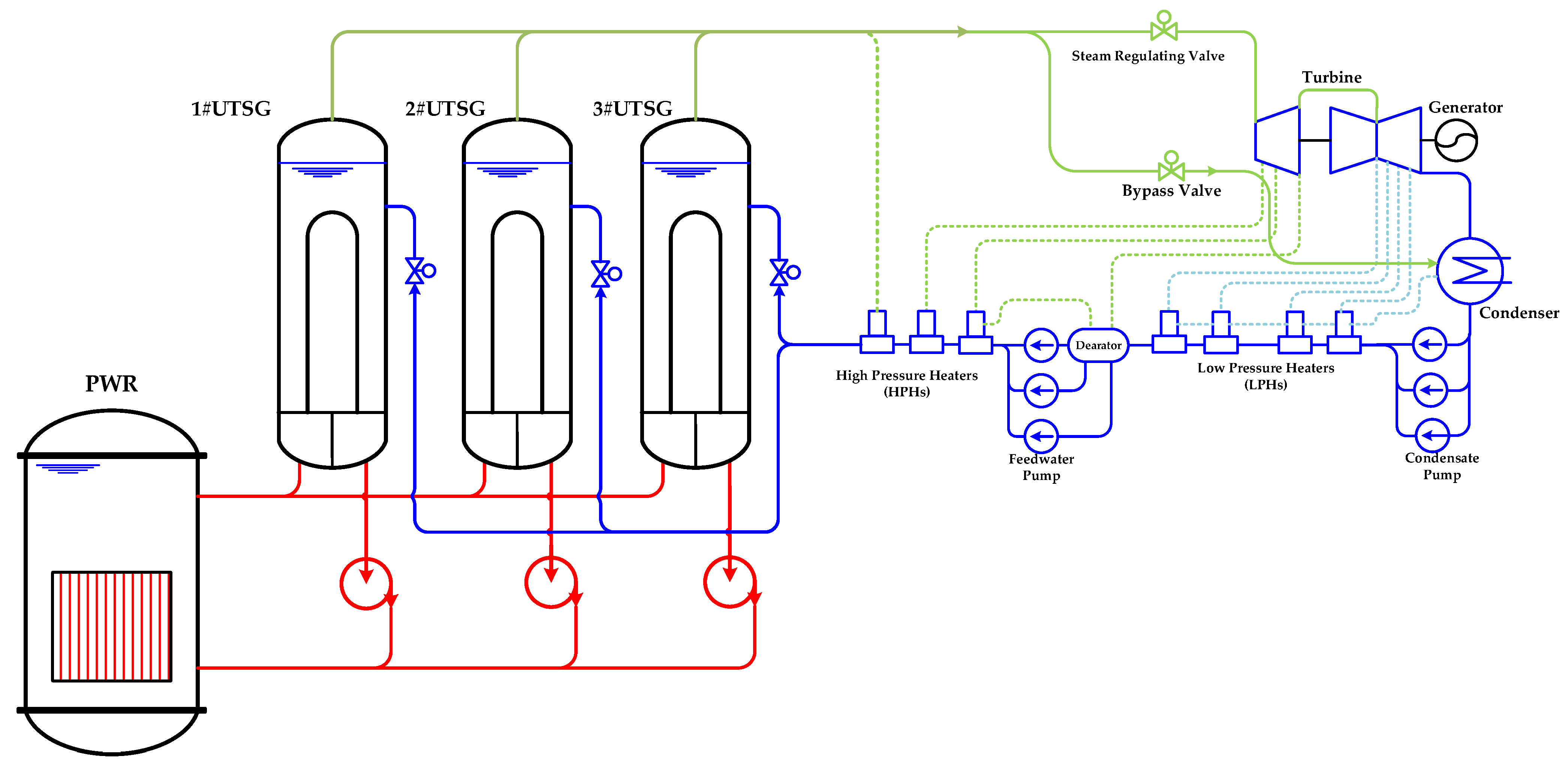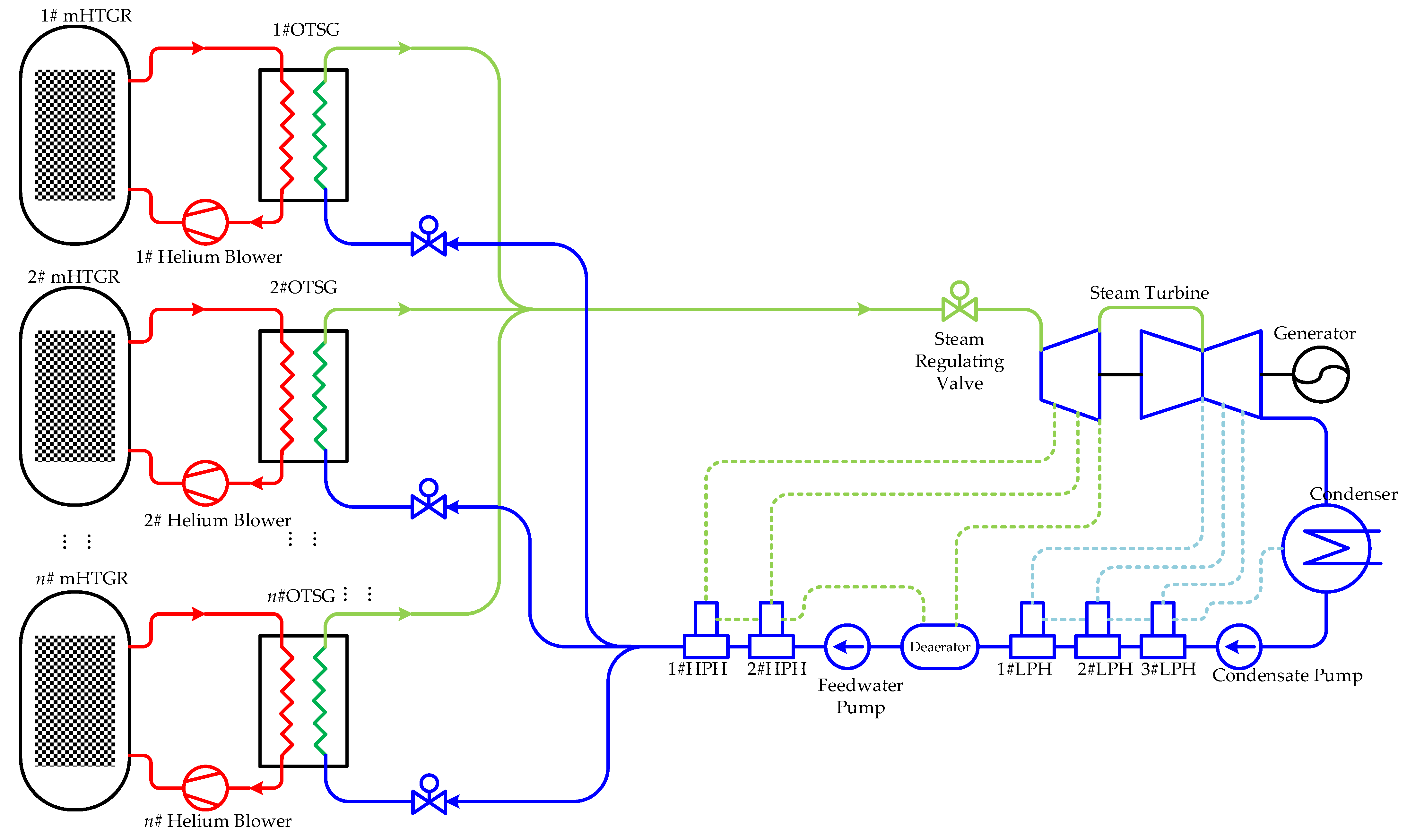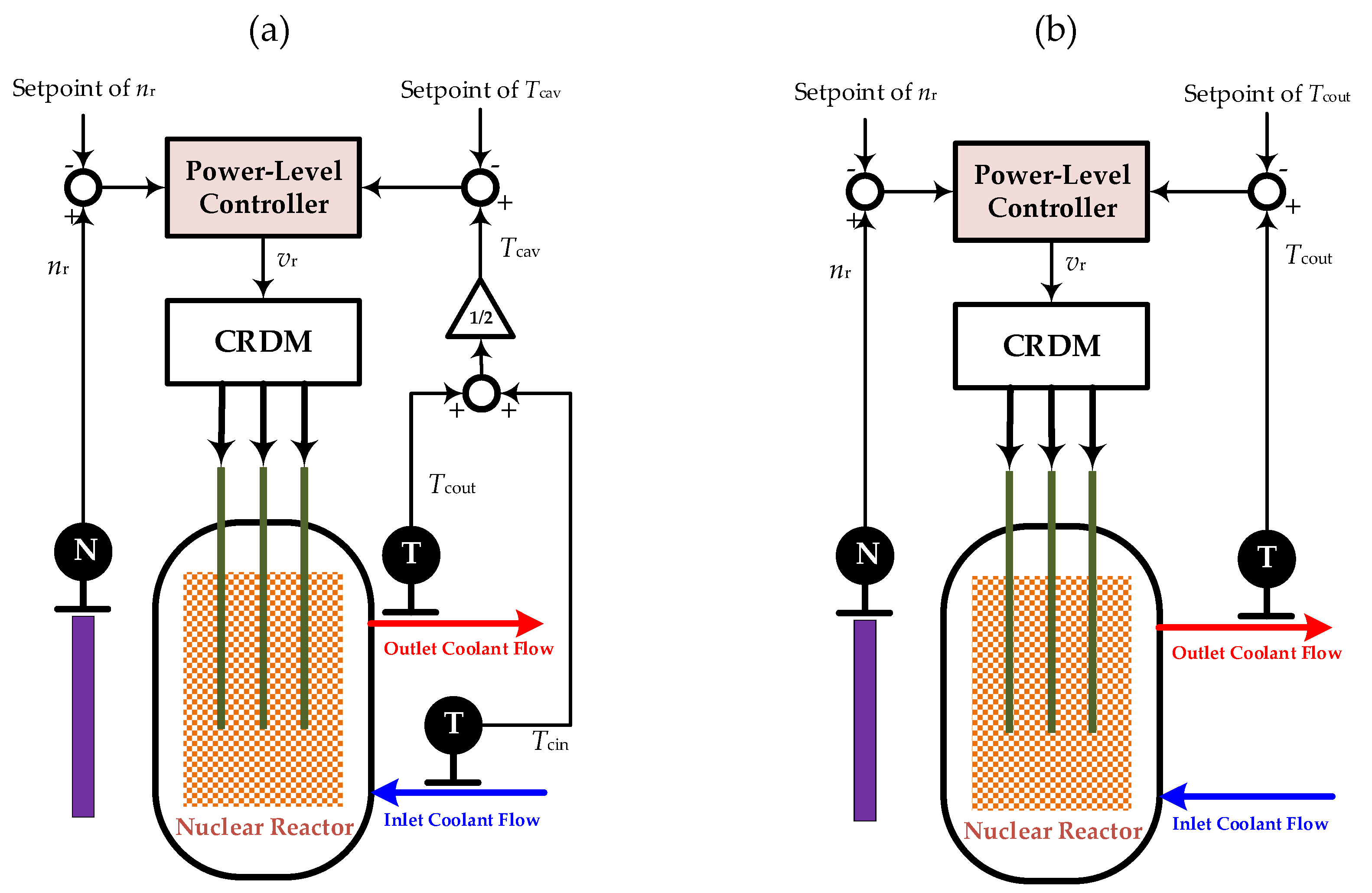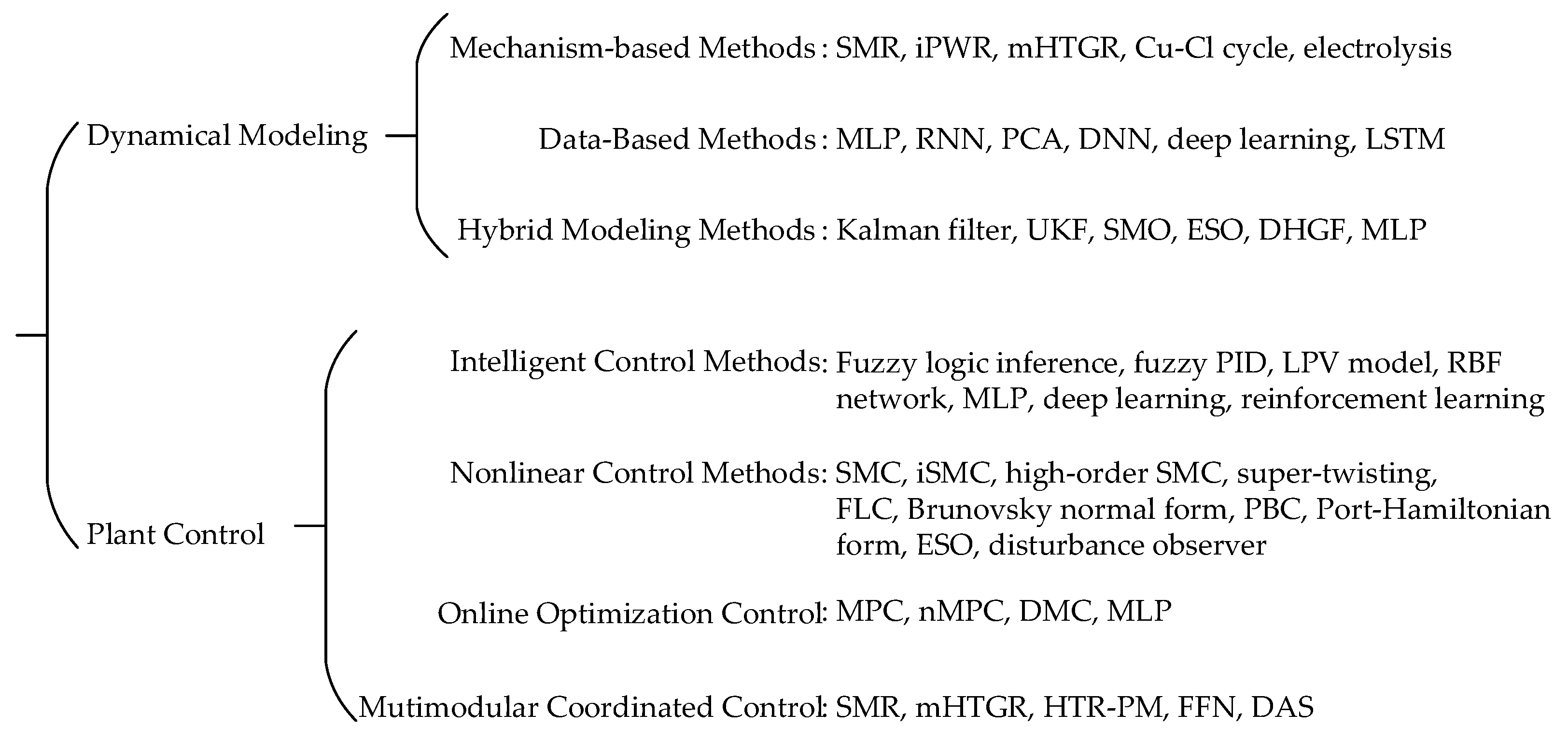Review on the Recent Progress in Nuclear Plant Dynamical Modeling and Control
Abstract
:1. Introduction
2. Dynamical Modeling
2.1. Mechanism-Based Modeling
2.2. Data-Based Modeling
2.3. Hybrid Modeling
3. Plant Control Methods
3.1. Intelligent Control
3.2. Nonlinear Control
3.3. Online Control Optimization
3.4. Multimodular Coordinated Control
4. Concluding Remarks and Future Directions
- (1)
- Interconnection Modeling
- (2)
- Joint Estimation of Parameters, States and Disturbances
- (3)
- Intelligent Nonlinear Control
- (4)
- Online Control Optimization
- (5)
- Coordinated Control of the Nuclear and Renewables
Author Contributions
Funding
Data Availability Statement
Conflicts of Interest
Nomenclature
| ADP | Adaptive Dynamic Programming |
| ANN | Artificial Neural Network |
| BP | Backpropagation |
| CCS | Coordinated Control System |
| DAS | Differential Algebraic System |
| DBN | Dynamic Bayesian Network |
| DHGF | Dissipation-based High Gain Filter |
| DL | Deep Learning |
| DMC | Dynamic Matrix Control |
| DNN | Deep Neural Network |
| EEMD | Ensemble Empirical Mode Decomposition |
| ESO | Extended State-Observer |
| FDI | Fault Detection and Isolation |
| FFN | Fluid Flow Network |
| FLC | Feedback Linearization Control |
| FLI | Fuzzy Logic Inference |
| HCPS | Human-Cyber-Physical System |
| HEN | Heat Exchanger Network |
| HIL | Hardware-In-the-Loop |
| HJB | Hamilton–Jacobi–Bellman |
| HPH | High Pressure Heater |
| HTE | High Temperature Electrolysis |
| HTGR | High Temperature Gas-cooled Reactor |
| HTR-PM | High Temperature Gas-cooled Reactor Pebble-bed Module |
| IPK | Inverse Point Kinetics |
| LPH | Low Pressure Heater |
| LPV | Linear Parameter Varying |
| LQG | Linear Quadratic Gaussian |
| LS | Least Square |
| LSTM | Long Short Term Memory |
| LTR | Loop Transfer Recovery |
| MCC | Multimodular Coordinated Control |
| MLP | Multilayer Perception |
| MPC | Model Predictive Control |
| MSR | Molten Salt Reactor |
| NCP | Nuclear Cogeneration Plant |
| NPP | Nuclear Power Plant |
| NSSS | Nuclear Steam Supply System |
| ODE | Ordinary Differential Equation |
| OTSG | Once-Through Steam Generator |
| PCA | Principle Component Analysis |
| PDE | Partial Differential Equation |
| PHF | Port-Hamiltonian Form |
| PID | Proportional-Integral-Differential |
| PSO | Particle Swarm Optimization |
| PV | Photovoltaic |
| PWR | Pressurized Water Reactor |
| RBF | Radial Basis Function |
| RLC | Reinforcement Learning Control |
| RNN | Recurrent Neural Network |
| SC | Soft Computing |
| SISO | Single-Input-Single-Output |
| SMR | Small Modular Reactor |
| SMC | Sliding Mode Control |
| SMO | Sliding Mode Observer |
| ST | Super-Twisting |
| UKF | Unscented Kalman Filter |
| UTSG | U-tube Steam Generator |
| eMPC | Explicit Model Predictive Control |
| iPWR | Integral Pressurized Water Reactor |
| iRLC | Integral Reinforcement Learning Control |
| iSMC | Integral Sliding Mode Control |
| mHTGR | Modular High Temperature Gas-cooled Reactor |
| nMPC | Nonlinear Model Predictive Control |
References
- Poudel, B.; Joshi, K.; Gokaraju, R. A dynamic model of small modular reactor based nuclear plant for power system studies. IEEE Trans. Energy Convers. 2020, 35, 977–985. [Google Scholar] [CrossRef]
- Poudel, B.; Gokaraju, R. Small modular reactor (SMR) based hybrid energy system for electricity & district heating. IEEE Trans. Energy Convers. 2021, 36, 2794–2802. [Google Scholar]
- Dong, Z.; Liu, M.; Huang, X.; Zhang, Y.; Zhang, Z.; Dong, Y. Dynamical modeling and simulation analysis of a nuclear desalination plant based on the MED-TVC process. Desalination 2019, 456, 121–135. [Google Scholar] [CrossRef]
- Dong, Z.; Pan, Y.; Zhang, Z.; Dong, Y.; Huang, X. Dynamical modeling and simulation of the six-modular high temperature gas-cooled reactor plant HTR-PM600. Energy 2018, 155, 971–991. [Google Scholar] [CrossRef]
- Dong, Z. Dynamical modeling and coordinated control design of a multimodular nuclear power-hydrogen cogeneration plant. Energy Convers. Manag. 2022, 272, 116369. [Google Scholar] [CrossRef]
- Rashdan, A.A.; Roberson, D. A frequency domain control perspective on Xenon resistance for load following of thermal nuclear reactors. IEEE Trans. Nucl. Sci. 2019, 66, 2034–2041. [Google Scholar] [CrossRef]
- Chen, W.; Liang, T.; Dinavahi, V. Comprehensive real-time hardware-in-the-loop transient emulation of MVDC power distribution system on nuclear submarine. IEEE Open J. Ind. Electron. Soc. 2020, 1, 326–339. [Google Scholar] [CrossRef]
- Saseed, A.; Rashid, A. Development of core monitoring system for a nuclear power plant using artificial neural network technique. Ann. Nucl. Energy 2020, 144, 107513. [Google Scholar] [CrossRef]
- El-Sefy, M.; Yosri, A.; El-Dakhakhni, W.; Nagaski, S.; Wiebe, L. Artificial neural network for predicting nuclear power plant dynamic behaviors. Nucl. Eng. Technol. 2021, 53, 3275–3285. [Google Scholar] [CrossRef]
- Laddach, K.; Langowski, R.; Rutkowski, T.A.; Puchalski, B. An automatic selection of optimal recurrent neural network architecture for process dynamics modelling purposes. Appl. Soft Comput. 2022, 116, 108375. [Google Scholar] [CrossRef]
- Foad, B.; Elzohery, R.; Novog, D.R. Demonstration of combined reduced order model and deep neural network for emulation of a time-dependent reactor transient. Ann. Nucl. Energy 2022, 171, 109017. [Google Scholar] [CrossRef]
- Lu, Q.; Yuan, Y.; Li, F.; Yang, B.; Li, Z.; Ma, Y.; Gu, Y.; Liu, D. Prediction method for thermal-hydraulic parameters of nuclear reactor system based on deep learning algorithm. Appl. Therm. Eng. 2021, 196, 117272. [Google Scholar] [CrossRef]
- Ramous, D.; Ramirez-Hereza, P.; Toledano, D.T.; Gonzalez-Rodriguez, J.; Ariza-Velazquez, A.; Solis-Tovar, D.; Munoz-Reja, C. Dynamic Bayesian networks for temporal prediction of chemical radioisotope levels in nuclear power plant reactors. Chemom. Intell. Lab. Syst. 2021, 214, 104327. [Google Scholar] [CrossRef]
- Nguyen, H.-P.; Baraldi, P.; Zio, E. Ensemble empirical mode decomposition and long short-term memory neural network for multi-step predictions of time series signals in nuclear power plants. Appl. Energy 2021, 283, 116346. [Google Scholar] [CrossRef]
- Mishra, A.K.; Shimjith, S.R.; Tiwari, A.P. Adaptive unscented Kalman filtering for reactivity estimation in nuclear power plants. IEEE Trans. Nucl. Sci. 2019, 66, 2388–2397. [Google Scholar] [CrossRef]
- Bhatt, T.U.; Patel, S.B.; Tiwari, A.P. Reactivity and delayed neutron precursors’ concentration estimation based on recursive nonlinear dynamic data reconciliation technique. IEEE Trans. Nucl. Sci. 2019, 66, 541–548. [Google Scholar] [CrossRef]
- Zahedi yeganeh, M.H.; Ansarifar, G.R. Estimation of the poisons reactivity in the P.W.R. nuclear reactor using modified higher order sliding mode observer based on the multi-point nuclear reactor model. Ann. Nucl. Energy 2018, 112, 158–169. [Google Scholar] [CrossRef]
- Dong, Z.; Feng, J.; Huang, X.; Zhang, L. Dissipation-based high gain filter for monitoring nuclear reactors. IEEE Trans. Nucl. Sci. 2010, 57, 328–339. [Google Scholar] [CrossRef]
- Dong, Z.; Liu, M.; Guo, Z.; Huang, X.; Zhang, Y.; Zhang, Z. Adaptive state-observer for monitoring flexible nuclear reactors. Energy 2019, 171, 893–909. [Google Scholar] [CrossRef]
- Dong, Z.; Huang, X.; Li, D.; Zhang, Z. Reactivity estimation based on an extended state observer of neutron kinetics. IEEE Trans. Nucl. Sci. 2016, 63, 2682–2690. [Google Scholar] [CrossRef]
- Dong, Z.; Li, B.; Li, J.; Huang, X.; Zhang, Z. Online reliability assessment of energy systems based on a high-order extended-state-observer with application to nuclear reactors. Renew. Sustain. Energy Rev. 2022, 158, 112159. [Google Scholar] [CrossRef]
- Dong, Z.; Li, J.; Li, B.; Guo, Z.; Huang, X.; Zhang, Z. Proportional-integral extended state-observer for monitoring nuclear reactors. IEEE Trans. Nucl. Sci. 2021, 68, 1207–1221. [Google Scholar] [CrossRef]
- Zhu, Y.; Dong, Z.; Huang, X.; Cheng, Z.; Dong, Y.; Zhang, Z. Neural network extended state-observer for energy system monitoring. Energy 2023, 263, 125736. [Google Scholar] [CrossRef]
- Istiqomah, A.; Subiantoro, A. Core power modelling of high-temperature engineering test reactor (HTTR) using nonlinear least squares method for parameter estimation. In Proceedings of the International Conference on Artificial Intelligence and Mechatronics Systems (AIMS), Bandung, Indonesia, 28–30 April 2021. [Google Scholar]
- Zhu, Y.; Dong, Z.; Li, D.; Huang, X.; Dong, Y.; Zhang, Z. A finite-time differentiator with application to nuclear reactor inverse period measurement. Energies 2022, 15, 4487. [Google Scholar] [CrossRef]
- Cho, S.; Jiang, J. Fault detection and identification for sensor channels in steam generator level control loops. IEEE Trans. Nucl. Sci. 2019, 66, 771–781. [Google Scholar] [CrossRef]
- Yellapu, V.S.; Vajpayee, V.; Tiwari, A.K. Online fault detection and isolation in advanced heavy water reactor using multiscale principle component analysis. IEEE Trans. Nucl. Sci. 2019, 66, 1790–1803. [Google Scholar] [CrossRef]
- Wang, P.; Zhang, J.; Wan, J.; Wu, S. A fault diagnosis method for small pressurized water reactors based on long short-term memory networks. Energy 2022, 239, 122298. [Google Scholar] [CrossRef]
- Feng, Y.; Jiang, X.; Hong, Z.; Li, Z.; Si, H.; Hu, B.; Zhang, Z.; Qiu, H.; Tan, J. Human-cyber-physical system for operation in nuclear reactor possessing asymmetric multi-task learning-based predicting framework. J. Manuf. Syst. 2022, 64, 443–453. [Google Scholar] [CrossRef]
- Ramezani, I.; Moshkbar-Bakhshayesh, K.; Vosoughi, N.; Ghofrani, M.B. Applications of soft computing in nuclear power plants. Prog. Nucl. Energy 2022, 149, 104253. [Google Scholar] [CrossRef]
- Wang, W.; Di Miao, F.; Zio, E. Hybrid fuzzy-PID control of a nuclear cyber-physical system working under varying environmental conditions. Nucl. Eng. Des. 2018, 331, 54–67. [Google Scholar] [CrossRef]
- Zeng, W.; Jiang, Q.; Liu, Y.; Yan, S.; Zhang, G.; Yu, T.; Xie, J. Core power control of a space nuclear reactor based on a nonlinear model and fuzzy-PID controller. Prog. Nucl. Energy 2021, 132, 103564. [Google Scholar] [CrossRef]
- Zeng, W.; Jiang, Q.; Xie, J.; Yu, T. A fuzzy-PID composite controller for core power control of liquid molten salt reactor. Ann. Nucl. Energy 2020, 139, 107234. [Google Scholar] [CrossRef]
- Zeng, W.; Jiang, Q.; Xie, J.; Yu, T. Core outlet fuel temperature control of liquid molten salt reactor during load following operation. Prog. Nucl. Energy 2020, 121, 103214. [Google Scholar] [CrossRef]
- Puchalski, B.; Rutkowski, T.A.; Duzinkiewicz, K. Fuzzy multi-regional fractional PID controller for pressurized water nuclear reactor. ISA Trans. 2020, 103, 86–102. [Google Scholar] [CrossRef]
- Jiang, Q.; Liu, Y.; Zeng, W.; Yu, T. Study on switching control of PWR core power with a fuzzy multimodel. Ann. Nucl. Energy 2020, 145, 107611. [Google Scholar] [CrossRef]
- Luan, X.; Wang, J.; Yang, Z.; Zhou, J. Load-following control of nuclear reactors based on fuzzy input-output model. Ann. Nucl. Energy 2021, 151, 107857. [Google Scholar] [CrossRef]
- Aftab, A.; Luan, X. A Takagi Sugeno based reactor power control of VVER-1000 using linear parameter varying identification of two-point kinetic model. Prog. Nucl. Energy 2021, 140, 103905. [Google Scholar] [CrossRef]
- Aftab, A.; Luan, X.; Anjum, M.S. Design of multi-module adaptive fuzzy power tracking control for nonlinear four-point reactor core model under multiple transient conditions. Prog. Nucl. Energy 2022, 149, 104248. [Google Scholar] [CrossRef]
- Zarei, M. Robust fuzzy gain scheduling power control of a generation IV nuclear reactor. Ann. Nucl. Energy 2022, 171, 109027. [Google Scholar] [CrossRef]
- Qian, H.; Zou, M. Design of digital nuclear power small reactor once-through steam generator control system. Nucl. Eng. Technol. 2022, 54, 2435–2443. [Google Scholar] [CrossRef]
- Wang, P.; Wan, J.; Wu, S.; Zhao, F. A fuzzy-logic-based pressure setpoint modification method for pressurized water reactor pressurizers. Ann. Nucl. Energy 2020, 135, 106954. [Google Scholar] [CrossRef]
- Ejigu, D.A.; Liu, X. Dynamic modeling and intelligent hybrid control of pressurized water reactor NPP power transient operation. Ann. Nucl. Energy 2022, 173, 109118. [Google Scholar] [CrossRef]
- Hui, J.; Yuan, J. Neural network-based adaptive fault-tolerant control for load following of a MHTGR with prescribed performance and CRDM faults. Energy 2022, 257, 124663. [Google Scholar] [CrossRef]
- Govindan, V.; Pappa, N. Online learning based neural network adaptive controller for efficient power tracking of PWR type reactor with unknown internal dynamics. Ann. Nucl. Energy 2022, 168, 108866. [Google Scholar] [CrossRef]
- Wan, J.; Jiang, Q.; Liao, L.; Wu, S.; Wang, P. A neural-network based variable universe fuzzy control method for power and axial power distribution control of large pressurized water reactors. Ann. Nucl. Energy 2022, 175, 109241. [Google Scholar] [CrossRef]
- Zhong, W.; Wang, M.; Wei, Q.; Lu, J. A new neuro-optimal nonlinear tracking control method via integral reinforcement learning with applications to nuclear systems. Neurocomputing 2022, 483, 361–369. [Google Scholar] [CrossRef]
- Lee, D.; Arigi, A.M.; Kim, J. Algorithm for autonomous power-increase operation using deep reinforcement learning and a rule-based system. IEEE Access 2020, 8, 196727–196743. [Google Scholar] [CrossRef]
- Dong, Z.; Huang, X.; Dong, Y.; Zhang, Z. Multilayer Perception based Reinforcement Learning Supervisory Control of Energy Systems with Application to a Nuclear Steam Supply System. Appl. Energy 2020, 259, 114193. [Google Scholar] [CrossRef]
- Zarei, M. Nonlinear PI output power regulation in a light water reactor. Prog. Nucl. Energy 2019, 110, 80–89. [Google Scholar] [CrossRef]
- Ansarifar, G.R.; Saadatzi, S. Nonlinear control for core power of pressurized water nuclear reactors using constant axial offset strategy. Nucl. Eng. Technol. 2015, 47, 838–848. [Google Scholar] [CrossRef]
- Hassanvand, R.; Ansarifar, G.R.; Nasrabadi, M.N. Nonlinear observer based control for travelling wave nuclear reactors based on the Lyapunov approach during load following operation. J. Process Control 2016, 46, 84–91. [Google Scholar] [CrossRef]
- Zaidabadi nejad, M.; Ansarifar, G.R. Adaptive observer based adaptive control for P.W.R nuclear reactors during load following operation with bounded xenon oscillations using Lyapunov approach. Ann. Nucl. Energy 2018, 121, 382–405. [Google Scholar] [CrossRef]
- Abdulraheem, K.K.; Korolev, S.A. Robust optimal-integral sliding mode control for a pressurized water nuclear reactor in load following mode of operation. Ann. Nucl. Energy 2021, 158, 108288. [Google Scholar] [CrossRef]
- Surjagade, P.V.; Shimjith, S.R.; Tiwari, A.P. Generalized extended state observer based integral sliding mode control for a nuclear reactor system with mismatched uncertainties. IFAC-PapersOnLine 2020, 53, 33–38. [Google Scholar] [CrossRef]
- Abdulraheem, K.K.; Tolokonsky, A.O.; Laidani, Z. Adaptive second-order sliding-mode control for a pressurized water nuclear reactor in load following operation with Xenon oscillation suppression. Nucl. Eng. Des. 2022, 391, 111742. [Google Scholar] [CrossRef]
- Wang, G.; Wu, J.; Zeng, B.; Xu, Z.; Ma, X. A chattering-free sliding mode control strategy for modular high-temperature gas-cooled reactors. Ann. Nucl. Energy 2019, 133, 688–695. [Google Scholar] [CrossRef]
- Cappelli, M.; Castillo-Toledo, B.; Di Gennaro, S. Nonlinear control of pressurized water reactors with uncertainties estimation via high order sliding mode. J. Frankl. Inst. 2021, 358, 1308–1326. [Google Scholar] [CrossRef]
- Kirgni, H.B.; Wang, J.; Asif, A. Static output feedback H∞ based integral sliding mode control law design for nuclear reactor power-level. Prog. Nucl. Energy 2022, 150, 104296. [Google Scholar] [CrossRef]
- Zarei, M. Nonlinear dynamics and control in molten salt reactors. Nucl. Eng. Des. 2018, 332, 289–296. [Google Scholar] [CrossRef]
- Alvarez-Ramirez, J.; Espinosa-Paredes, G. A modeling error compensation approach for the feedback control of the nuclear reactor operation. Nucl. Eng. Des. 2021, 382, 111394. [Google Scholar] [CrossRef]
- Zaidabadi nejad, M.; Ansarifar, G.R. Observer based adaptive robust feedback-linearization control for VVER-1000 nuclear reactors with bounded axial power distribution based on the validated multipoint kinetics reactor model. Ann. Nucl. Energy 2020, 142, 107380. [Google Scholar] [CrossRef]
- Zhang, X.; Sun, P.; Wei, X. Design of an output feedback pressurizer controller with a decoupling precompensator for PWRs. IEEE Trans. Nucl. Sci. 2022, 69, 1712–1724. [Google Scholar] [CrossRef]
- Dong, Z. Sufficient conditions for globally asymptotic self-stability of pressurized water reactors. Ann. Nucl. Energy 2014, 63, 387–398. [Google Scholar] [CrossRef]
- Dong, Z. PD power-level control design for PWRs: A physically-based approach. IEEE Trans. Nucl. Sci. 2013, 60, 3889–3898. [Google Scholar] [CrossRef]
- Dong, Z.; Li, B.; Huang, X.; Dong, Y.; Zhang, Z. Port-Hamiltonian Control of Nuclear Reactors. IEEE Trans. Nucl. Sci. 2022, 69, 1022–1036. [Google Scholar] [CrossRef]
- Zhu, Y.; Dong, Z.; Huang, X.; Dong, Y.; Zhang, Y.; Zhang, Z. Passivity-based power-level control of nuclear reactors. Energies 2022, 15, 4779. [Google Scholar] [CrossRef]
- Dong, Z.; Zhang, Z.; Dong, Y.; Huang, X. Cascaded HTGR power-level control only by regulating primary helium flowrate. IEEE Trans. Nucl. Sci. 2020, 67, 1780–1790. [Google Scholar] [CrossRef]
- Dong, Z.; Li, B.; Li, J.; Jiang, D.; Guo, Z.; Huang, X.; Zhang, Z. Passivity based control of heat exchanger networks with application to nuclear heating. Energy 2021, 223, 120107. [Google Scholar] [CrossRef]
- Dong, Z.; Liu, M.; Zhang, Z.; Dong, Y.; Huang, X. Automatic Generation Control for the Flexible Operation of Multimodular High Temperature Gas-cooled Reactor Plants. Renew. Sustain. Energy Rev. 2019, 108, 11–31. [Google Scholar] [CrossRef]
- Dong, Z.; Li, B.; Li, J.; Guo, Z.; Huang, X.; Zhang, Y.; Zhang, Z. Flexible control of nuclear cogeneration plants for balancing intermittent renewables. Energy 2021, 221, 119906. [Google Scholar] [CrossRef]
- Zhao, C.; Yang, X.; Yang, M.; Wang, J.; Chen, S. Research for axial power distribution control of a space nuclear reactor based on nonlinear model. Ann. Nucl. Energy 2022, 168, 108917. [Google Scholar] [CrossRef]
- Na, M.G.; Shin, S.H.; Kim, W.C. A model predictive controller for nuclear reactor power. J. Korean Nucl. Soc. 2003, 35, 399–411. [Google Scholar]
- Dupré, G.; Grossetête, A.; Chevrel, P.; Yagoubi, M. Enhanced flexibility of PWRs (Mode A) using an efficient NMPC-based boration/dilution system. In Proceedings of the European Control Conference (ECC), Rotterdam, The Netherlands, 29 June–2 July 2021. [Google Scholar]
- Pradhan, S.K.; Das, D.K. Explicit model predictive controller for power control of molten salt breeder reactor core. Nucl. Eng. Des. 2021, 384, 111492. [Google Scholar] [CrossRef]
- Vajpayee, V.; Mukhopadhyay, S.; Tiwari, A.P. Data-driven subspace predictive control of a nuclear reactor. IEEE Trans. Nucl. Sci. 2018, 65, 666–679. [Google Scholar] [CrossRef]
- Jiang, D.; Dong, Z.; Liu, M.; Huang, X. Dynamic matrix control for the thermal power of MHTGR-based nuclear steam supply system. Energies 2018, 11, 2651. [Google Scholar] [CrossRef]
- Jiang, D.; Dong, Z. Practical dynamic matrix control of MHTGR-based nuclear steam supply systems. Energy 2019, 185, 695–707. [Google Scholar] [CrossRef]
- Xiao, K.; Wu, Q.; Chen, J.; Pu, X.; Zhang, Y.; Yang, P. A neural network predictive control method for power control of small pressurized water reactors. Ann. Nucl. Energy 2022, 169, 108946. [Google Scholar] [CrossRef]
- Dong, Z.; Zhang, Z.; Dong, Y.; Huang, X. Multi-layer perception based model predictive control for the thermal power of nuclear superheated-steam supply systems. Energy 2018, 151, 116–125. [Google Scholar] [CrossRef]
- Dong, Z. Model-free coordinated control of MHTGR-based nuclear steam supply systems. Energies 2016, 9, 37. [Google Scholar] [CrossRef]
- Dong, Z.; Pan, Y.; Zhang, Z.; Dong, Y.; Huang, X. Model-free adaptive control law for nuclear superheated-steam supply systems. Energy 2017, 135, 53–67. [Google Scholar] [CrossRef]
- Dong, Z.; Song, M.; Huang, X.; Zhang, Z.; Wu, Z. Module coordination control of MHTGR-based multi-modular nuclear plants. IEEE Trans. Nucl. Sci. 2016, 63, 1889–1900. [Google Scholar] [CrossRef]
- Dong, Z.; Song, M.; Huang, X.; Zhang, Z.; Wu, Z. Coordination control of SMR-based NSSS modules integrated by feedwater distribution. IEEE Trans. Nucl. Sci. 2016, 63, 2691–2697. [Google Scholar] [CrossRef]
- WNN. Available online: https://www.world-nuclear-news.org/Articles/China-s-demonstration-HTR-PM-reaches-full-power (accessed on 9 December 2022).
- Nuerlan, A.; Wan, J.; Wang, P.; Zhao, F. Decoupling control of both turbine power and reactor power in a marine use multi-reactor and multi-turbine nuclear power plant. Prog. Nucl. Energy 2021, 132, 103598. [Google Scholar] [CrossRef]
- Wu, S.; Nuerlan, A.; Wan, J.; Wang, P.; Su, G.H. A feedforward-feedback-based reactor power decoupling control strategy for multi-modular nuclear power plants. Prog. Nucl. Energy 2022, 144, 104074. [Google Scholar] [CrossRef]
- Jiang, D.; Dong, Z.; Huang, X.; Dong, Y.; Zhang, Z. Dynamic matrix control for thermal power of multi-modular high temperature gas-cooled reactor plants. Energy 2020, 198, 117386. [Google Scholar] [CrossRef]




Disclaimer/Publisher’s Note: The statements, opinions and data contained in all publications are solely those of the individual author(s) and contributor(s) and not of MDPI and/or the editor(s). MDPI and/or the editor(s) disclaim responsibility for any injury to people or property resulting from any ideas, methods, instructions or products referred to in the content. |
© 2023 by the authors. Licensee MDPI, Basel, Switzerland. This article is an open access article distributed under the terms and conditions of the Creative Commons Attribution (CC BY) license (https://creativecommons.org/licenses/by/4.0/).
Share and Cite
Dong, Z.; Cheng, Z.; Zhu, Y.; Huang, X.; Dong, Y.; Zhang, Z. Review on the Recent Progress in Nuclear Plant Dynamical Modeling and Control. Energies 2023, 16, 1443. https://doi.org/10.3390/en16031443
Dong Z, Cheng Z, Zhu Y, Huang X, Dong Y, Zhang Z. Review on the Recent Progress in Nuclear Plant Dynamical Modeling and Control. Energies. 2023; 16(3):1443. https://doi.org/10.3390/en16031443
Chicago/Turabian StyleDong, Zhe, Zhonghua Cheng, Yunlong Zhu, Xiaojin Huang, Yujie Dong, and Zuoyi Zhang. 2023. "Review on the Recent Progress in Nuclear Plant Dynamical Modeling and Control" Energies 16, no. 3: 1443. https://doi.org/10.3390/en16031443
APA StyleDong, Z., Cheng, Z., Zhu, Y., Huang, X., Dong, Y., & Zhang, Z. (2023). Review on the Recent Progress in Nuclear Plant Dynamical Modeling and Control. Energies, 16(3), 1443. https://doi.org/10.3390/en16031443








